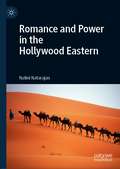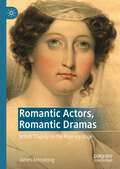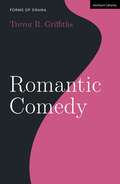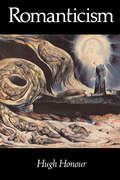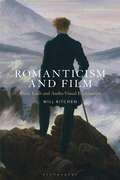- Table View
- List View
Romance and Power in the Hollywood Eastern
by Nalini NatarajanThis book develops the idea of the "Eastern" as an analytically significant genre of film. Positioned in counterpoint to the Western, the famed cowboy genre of the American frontier, the “Eastern” encompasses films that depict the eastern and southern frontiers of Euro-American expansion. Examining six films in particular—Gunga Din (1939), Lawrence of Arabia (1962), Heat and Dust (1983), A Passage to India (1984), Indochine (1992), and The English Patient (1996)—the author explores the duality of the "Eastern" as both aggressive and seductive, depicting conquest and romance at the same time. In juxtaposing these two elements, the book seeks to reveal the double process by which the “Eastern” both diminishes the "East" and Global South and reinforces ignorance about these regions’ histories and complexity, thereby setting the stage for ever-escalating political aggression.
Romance in Post-Socialist Chinese Television (East Asian Popular Culture)
by Huike WenThis book is about how the representations of romantic love in television reflect the change and the dilemma of the dominant values in post-socialist Chinese mainstream culture. These values mainly center on the impact of individualism, consumerism, capitalism, and neoliberalism, often referred to as western culture, on the perception of romantic love and self-realization in China.The book focuses on how romantic love, which plays a vital role in China’s ideologically highly restricted social environment by empowering people with individual choice, change, and social mobility, must struggle and compromise with the reality, specifically the values and problems emerging in a transitional China. The book also examines how the representation of romantic love celebrates ideals—individual freedom, passion, and gender equality—and promises changes based on individual diligence and talent while simultaneously obstructing the fulfillment of these ideals.
The Romance of Three Hamlets: Shakespeare through a Chinese Prism
by Hao LiuThrough a metaphorical journey of Shakespeare in traditional Chinese theatre, using three Chinese opera productions of Hamlet as signposts, the book discusses the relationship between Shakespeare and Chinese theatrical traditions.A brief discussion of the Yue-opera Hamlet looks back at the role of Shakespeare in the Chinese discourse of renaissance and re-evaluation of traditions since the early twentieth century. A detailed analysis of the Peking-opera Hamlet shows what is lost and what is gained in the negotiation between Shakespeare and Chinese theatrical traditions, and why. The third Hamlet is an experimental Kun-opera production, leading to a discussion of the potential for Shakespeare and Chinese theatrical traditions to join hands and reach new depths of artistic expression.The book will attract researchers, students, and enthusiasts of Shakespeare, cross-cultural Shakespearean recreation, Chinese theatrical traditions, and comparative literature.
The Romance of Three Hamlets: Shakespeare through a Chinese Prism
by Hao LiuThrough a metaphorical journey of Shakespeare in traditional Chinese theatre, using three Chinese opera productions of Hamlet as signposts, the book discusses the relationship between Shakespeare and Chinese theatrical traditions.A brief discussion of the Yue-opera Hamlet looks back at the role of Shakespeare in the Chinese discourse of renaissance and re-evaluation of traditions since the early twentieth century. A detailed analysis of the Peking-opera Hamlet shows what is lost and what is gained in the negotiation between Shakespeare and Chinese theatrical traditions, and why. The third Hamlet is an experimental Kun-opera production, leading to a discussion of the potential for Shakespeare and Chinese theatrical traditions to join hands and reach new depths of artistic expression.The book will attract researchers, students, and enthusiasts of Shakespeare, cross-cultural Shakespearean recreation, Chinese theatrical traditions, and comparative literature.
Romance on the Early Modern Stage: English Expansion Before and After Shakespeare
by Cyrus MulreadyWhat is dramatic romance? Scholars have long turned to Shakespeare's biography to answer this question, marking his 'late plays' as the beginning and end of the dramatic romance. This book identifies an earlier history for this genre, revealing how stage romances imaginatively expanded audience interest in England's emerging global economy.
Romanesque Architectural Sculpture: The Charles Eliot Norton Lectures (The\charles Eliot Norton Lectures)
by Meyer SchapiroMeyer Schapiro (1904-96), renowned for his critical essays on nineteenth- and twentieth-century painting, also played a decisive role as a young scholar in defining the style of art and architecture known as Romanesque. And, appropriately, when he was invited to deliver the prestigious Charles Eliot Norton Lectures at Harvard, he chose Romanesque architectural sculpture as his topic. These lectures, acclaimed for the verve and freshness with which Schapiro delivered them, languished unpublished for decades. But Linda Seidel, who knew Schapiro well and attended the 1967 lectures, has now expertly transcribed and edited them, presenting them for the first time to an audience beyond the halls of Harvard. In editing the lectures, Seidel closely followed the recordings of the originals. Sentences are rendered as Schapiro spoke them, affording readers a unique opportunity to experience the legendary teacher as he rarely appears in print: forming his thoughts spontaneously, interrupting himself to develop related ideas, and responding to the audience’s interests by introducing humorous asides. Nonetheless, these lectures are carefully constructed, demonstrating Schapiro’s commitment to the originality and value of artistic production and affirming his lifelong belief in artists’ engagement with their cultures. Amply illustrated with many key works and augmented with Seidel’s indispensable introduction, this long-awaited volume will delight students and scholars of art history, as well as anyone interested in seeing a new side of a profoundly influential mind.
Romanian Cinema: Thinking Outside the Screen
by Doru PopThis volume explores the philosophical and metaphysical manifestations of contemporary cinema. Starting with the hypothesis that movies provide an experience that is both a pathway into the thinking mechanisms of modern humans and into our collective psyche, this study focuses on the elements that form the “Romanian cinematic mind” as part of the European cinema-thinking. While this book is based on specific case studies provided by recent productions in Romanian filmmaking, such as Proroca (2017) and Touch me Not (2018), it also contextualises the national cinema within the larger, European art of making movies. Offering close interpretations of the works of world-renowned directors like Cristi Puiu, Cristian Mungiu, Corneliu Porumboiu or more recently Adina Pintilie and Constantin Popescu, this book questions the “Romanianess” of their cinematic techniques, and places their philosophical roots both in a particular mode of thinking and within continental philosophy.
Romanian Cinema: Thinking Outside the Screen
by Doru PopThis volume explores the philosophical and metaphysical manifestations of contemporary cinema. Starting with the hypothesis that movies provide an experience that is both a pathway into the thinking mechanisms of modern humans and into our collective psyche, this study focuses on the elements that form the “Romanian cinematic mind” as part of the European cinema-thinking. While this book is based on specific case studies provided by recent productions in Romanian filmmaking, such as Proroca (2017) and Touch me Not (2018), it also contextualises the national cinema within the larger, European art of making movies. Offering close interpretations of the works of world-renowned directors like Cristi Puiu, Cristian Mungiu, Corneliu Porumboiu or more recently Adina Pintilie and Constantin Popescu, this book questions the “Romanianess” of their cinematic techniques, and places their philosophical roots both in a particular mode of thinking and within continental philosophy.
Romantic Actors, Romantic Dramas: British Tragedy on the Regency Stage
by James ArmstrongThis book reinterprets British dramas of the early-nineteenth century through the lens of the star actors for whom they were written. Unlike most playwrights of previous generations, the writers of British Romantic dramas generally did not work in the theatre themselves. However, they closely followed the careers of star performers. Even when they did not directly know actors, they had what media theorists have dubbed "para-social interactions" with those stars, interacting with them through the mediation of mass communication, whether as audience members, newspaper and memoir readers, or consumers of prints, porcelain miniatures, and other manifestations of "fan" culture. This study takes an in-depth look at four pairs of performers and playwrights: Sarah Siddons and Joanna Baillie, Julia Glover and Samuel Taylor Coleridge, Edmund Kean and Lord Byron, and Eliza O'Neill and Percy Bysshe Shelley. These charismatic performers, knowingly or not, helped to guide the development of a character-based theatre—from the emotion-dominated plays made popular by Baillie to the pinnacle of Romantic drama under Shelley. They shepherded in a new style of writing that had verbal sophistication and engaged meaningfully with the moral issues of the day. They helped to create not just new modes of acting, but new ways of writing that could make use of their extraordinary talents.
Romantic Comedy (Forms of Drama)
by Trevor R. Griffiths'The course of true love never did run smooth' – so says Lysander in A Midsummer Night's Dream, and for more than 2000 years the problems faced by young men and women fighting to find and keep an appropriate sexual partner have been a theatrical staple. This book explores the shapes that Romantic Comedy has assumed from Greek New Comedy via Shakespeare to the present. Changing social values have helped to redefine the genre's traditional hetero-normativity, while the recent trend towards more fluid casting has opened up many romantic comedies to radical reinterpretations. Organized chronologically to allow readers to trace the development of the form against changing societal norms, the book features a range of case studies of key works from the British tradition, including A Midsummer Night's Dream, Twelfth Night, Susanna Centlivre's A Bold Stroke for a Wife, Oliver Goldsmith's She Stoops to Conquer, Stanley Houghton's Hindle Wakes, Noël Coward's Private Lives, Shelagh Delaney's A Taste of Honey, Ayub Khan-Din's East is East and David Eldridge's Beginning.
Romantic Comedy (Forms of Drama)
by Trevor R. Griffiths'The course of true love never did run smooth' – so says Lysander in A Midsummer Night's Dream, and for more than 2000 years the problems faced by young men and women fighting to find and keep an appropriate sexual partner have been a theatrical staple. This book explores the shapes that Romantic Comedy has assumed from Greek New Comedy via Shakespeare to the present. Changing social values have helped to redefine the genre's traditional hetero-normativity, while the recent trend towards more fluid casting has opened up many romantic comedies to radical reinterpretations. Organized chronologically to allow readers to trace the development of the form against changing societal norms, the book features a range of case studies of key works from the British tradition, including A Midsummer Night's Dream, Twelfth Night, Susanna Centlivre's A Bold Stroke for a Wife, Oliver Goldsmith's She Stoops to Conquer, Stanley Houghton's Hindle Wakes, Noël Coward's Private Lives, Shelagh Delaney's A Taste of Honey, Ayub Khan-Din's East is East and David Eldridge's Beginning.
The Romantic Fiction Of Mills & Boon, 1909-1995 (Women's and Gender History)
by Dixon, Jay Jay Dixon.This study to analyzes romantic fiction's depiction of women as part of the broader history of ideas about women.; Given the success of the Mills & Boon romance, their portrayal of subjects like sex, love, marriage, class, motherhood and femineity are important cultural barometers and make interesting study.; The author shows how all these themes have an historical trajectory and how these novels have come to reflect feminist concerns.; Based on a study of over 1000 Mills & Boon romances the book provides analysis of plot types and shows how these have changed in response to women's own changing position within society.
The Romantic Fiction Of Mills & Boon, 1909-1995 (Women's and Gender History)
by Dixon, Jay Jay Dixon.This study to analyzes romantic fiction's depiction of women as part of the broader history of ideas about women.; Given the success of the Mills & Boon romance, their portrayal of subjects like sex, love, marriage, class, motherhood and femineity are important cultural barometers and make interesting study.; The author shows how all these themes have an historical trajectory and how these novels have come to reflect feminist concerns.; Based on a study of over 1000 Mills & Boon romances the book provides analysis of plot types and shows how these have changed in response to women's own changing position within society.
Romantic Things: A Tree, a Rock, a Cloud
by Mary JacobusOur thoughts are shaped as much by what things make of us as by what we make of them. Lyric poetry is especially concerned with things and their relationship to thought, sense, and understanding. In Romantic Things, Mary Jacobus explores the world of objects and phenomena in nature as expressed in Romantic poetry alongside the theme of sentience and sensory deprivation in literature and art. Jacobus discusses objects and attributes that test our perceptions and preoccupy both Romantic poetry and modern philosophy. John Clare, John Constable, Rainer Maria Rilke, W. G. Sebald, and Gerhard Richter make appearances around the central figure of William Wordsworth as Jacobus explores trees, rocks, clouds, breath, sleep, deafness, and blindness in their work. While she thinks through these things, she is assisted by the writings of Maurice Merleau-Ponty, Jacques Derrida, and Jean-Luc Nancy. Helping us think more deeply about things that are at once visible and invisible, seen and unseen, felt and unfeeling, Romantic Things opens our eyes to what has been previously overlooked in lyric and Romantic poetry.
Romantic Things: A Tree, a Rock, a Cloud
by Mary JacobusOur thoughts are shaped as much by what things make of us as by what we make of them. Lyric poetry is especially concerned with things and their relationship to thought, sense, and understanding. In Romantic Things, Mary Jacobus explores the world of objects and phenomena in nature as expressed in Romantic poetry alongside the theme of sentience and sensory deprivation in literature and art. Jacobus discusses objects and attributes that test our perceptions and preoccupy both Romantic poetry and modern philosophy. John Clare, John Constable, Rainer Maria Rilke, W. G. Sebald, and Gerhard Richter make appearances around the central figure of William Wordsworth as Jacobus explores trees, rocks, clouds, breath, sleep, deafness, and blindness in their work. While she thinks through these things, she is assisted by the writings of Maurice Merleau-Ponty, Jacques Derrida, and Jean-Luc Nancy. Helping us think more deeply about things that are at once visible and invisible, seen and unseen, felt and unfeeling, Romantic Things opens our eyes to what has been previously overlooked in lyric and Romantic poetry.
Romantic Things: A Tree, a Rock, a Cloud
by Mary JacobusOur thoughts are shaped as much by what things make of us as by what we make of them. Lyric poetry is especially concerned with things and their relationship to thought, sense, and understanding. In Romantic Things, Mary Jacobus explores the world of objects and phenomena in nature as expressed in Romantic poetry alongside the theme of sentience and sensory deprivation in literature and art. Jacobus discusses objects and attributes that test our perceptions and preoccupy both Romantic poetry and modern philosophy. John Clare, John Constable, Rainer Maria Rilke, W. G. Sebald, and Gerhard Richter make appearances around the central figure of William Wordsworth as Jacobus explores trees, rocks, clouds, breath, sleep, deafness, and blindness in their work. While she thinks through these things, she is assisted by the writings of Maurice Merleau-Ponty, Jacques Derrida, and Jean-Luc Nancy. Helping us think more deeply about things that are at once visible and invisible, seen and unseen, felt and unfeeling, Romantic Things opens our eyes to what has been previously overlooked in lyric and Romantic poetry.
Romantic Things: A Tree, a Rock, a Cloud
by Mary JacobusOur thoughts are shaped as much by what things make of us as by what we make of them. Lyric poetry is especially concerned with things and their relationship to thought, sense, and understanding. In Romantic Things, Mary Jacobus explores the world of objects and phenomena in nature as expressed in Romantic poetry alongside the theme of sentience and sensory deprivation in literature and art. Jacobus discusses objects and attributes that test our perceptions and preoccupy both Romantic poetry and modern philosophy. John Clare, John Constable, Rainer Maria Rilke, W. G. Sebald, and Gerhard Richter make appearances around the central figure of William Wordsworth as Jacobus explores trees, rocks, clouds, breath, sleep, deafness, and blindness in their work. While she thinks through these things, she is assisted by the writings of Maurice Merleau-Ponty, Jacques Derrida, and Jean-Luc Nancy. Helping us think more deeply about things that are at once visible and invisible, seen and unseen, felt and unfeeling, Romantic Things opens our eyes to what has been previously overlooked in lyric and Romantic poetry.
Romantic Things: A Tree, a Rock, a Cloud
by Mary JacobusOur thoughts are shaped as much by what things make of us as by what we make of them. Lyric poetry is especially concerned with things and their relationship to thought, sense, and understanding. In Romantic Things, Mary Jacobus explores the world of objects and phenomena in nature as expressed in Romantic poetry alongside the theme of sentience and sensory deprivation in literature and art. Jacobus discusses objects and attributes that test our perceptions and preoccupy both Romantic poetry and modern philosophy. John Clare, John Constable, Rainer Maria Rilke, W. G. Sebald, and Gerhard Richter make appearances around the central figure of William Wordsworth as Jacobus explores trees, rocks, clouds, breath, sleep, deafness, and blindness in their work. While she thinks through these things, she is assisted by the writings of Maurice Merleau-Ponty, Jacques Derrida, and Jean-Luc Nancy. Helping us think more deeply about things that are at once visible and invisible, seen and unseen, felt and unfeeling, Romantic Things opens our eyes to what has been previously overlooked in lyric and Romantic poetry.
Romantic Things: A Tree, a Rock, a Cloud
by Mary JacobusOur thoughts are shaped as much by what things make of us as by what we make of them. Lyric poetry is especially concerned with things and their relationship to thought, sense, and understanding. In Romantic Things, Mary Jacobus explores the world of objects and phenomena in nature as expressed in Romantic poetry alongside the theme of sentience and sensory deprivation in literature and art. Jacobus discusses objects and attributes that test our perceptions and preoccupy both Romantic poetry and modern philosophy. John Clare, John Constable, Rainer Maria Rilke, W. G. Sebald, and Gerhard Richter make appearances around the central figure of William Wordsworth as Jacobus explores trees, rocks, clouds, breath, sleep, deafness, and blindness in their work. While she thinks through these things, she is assisted by the writings of Maurice Merleau-Ponty, Jacques Derrida, and Jean-Luc Nancy. Helping us think more deeply about things that are at once visible and invisible, seen and unseen, felt and unfeeling, Romantic Things opens our eyes to what has been previously overlooked in lyric and Romantic poetry.
Romantic Women Writers Reviewed, Part I Vol 3
by Ann R Hawkins Stephanie EckrothThis multi-volume reset collection will addresses significant shortfall in scholarly work, offering contemporary reviews of the work of Romantic women writers to a wider audience.
Romantic Women Writers Reviewed, Part I Vol 3
by Ann R Hawkins Stephanie EckrothThis multi-volume reset collection will addresses significant shortfall in scholarly work, offering contemporary reviews of the work of Romantic women writers to a wider audience.
Romanticism (Icon Editions Ser.)
by Hugh Honour"This stylish and erudite thematic study of the influence Romanticism exerts upon Western culture and particularly the visual arts is the companion volume to Honour's equally valuable Neo-classicism.... The text is supported by a useful selection of illustrations Excellent footnotes and a good index. Finely produced, Romanticism will stimulate the graduate and inform the undergraduate." —Choice "An interpretation that rings true for our own time.... His approach to his vast subject is essentially cool, analytic and balanced This is a book that covers an immense amount of material with a freshness of touch." —John Russell, The New York Times "A book of great interest and quality which gives form to a subject that is often treated very vaguely." —Kenneth Clark
Romanticism and Film: Franz Liszt and Audio-Visual Explanation
by Will KitchenThe relationship between Romanticism and film remains one of the most neglected topics in film theory and history, with analysis often focusing on the proto-cinematic significance of Richard Wagner's music-dramas. One new and interesting way of examining this relationship is by looking beyond Wagner, and developing a concept of audio-visual explanation rooted in Romantic philosophical aesthetics, and employing it in the analysis of film discourse and representation. Using this concept of audio-visual explanation, the cultural image of the Hungarian pianist and composer Franz Liszt, a contemporary of Wagner and another significant practitioner of Romantic audio-visual aesthetics, is examined in reference to specific case studies, including the rarely-explored films Song Without End (1960) and Lisztomania (1975). This multifaceted study of film discourse and representation employs Liszt as a guiding-thread, structuring a general exploration of the concept of Romanticism and its relationship with film more generally. This exploration is supported by new theories of representation based on schematic cognition, the philosophy of explanation, and the recently-developed film theory of Jacques Rancière.Individual chapters address the historical background of audio-visual explanation in Romantic philosophical aesthetics, Liszt's role in the historical discourses of film and film music, and various filmic representations of Liszt and his compositions. Throughout these investigations, Will Kitchen explores the various ways that films explain, or 'make sense' of things, through a 'Romantic' aesthetic combination of sound and vision.
Romanticism and Film: Franz Liszt and Audio-Visual Explanation
by Will KitchenThe relationship between Romanticism and film remains one of the most neglected topics in film theory and history, with analysis often focusing on the proto-cinematic significance of Richard Wagner's music-dramas. One new and interesting way of examining this relationship is by looking beyond Wagner, and developing a concept of audio-visual explanation rooted in Romantic philosophical aesthetics, and employing it in the analysis of film discourse and representation. Using this concept of audio-visual explanation, the cultural image of the Hungarian pianist and composer Franz Liszt, a contemporary of Wagner and another significant practitioner of Romantic audio-visual aesthetics, is examined in reference to specific case studies, including the rarely-explored films Song Without End (1960) and Lisztomania (1975). This multifaceted study of film discourse and representation employs Liszt as a guiding-thread, structuring a general exploration of the concept of Romanticism and its relationship with film more generally. This exploration is supported by new theories of representation based on schematic cognition, the philosophy of explanation, and the recently-developed film theory of Jacques Rancière.Individual chapters address the historical background of audio-visual explanation in Romantic philosophical aesthetics, Liszt's role in the historical discourses of film and film music, and various filmic representations of Liszt and his compositions. Throughout these investigations, Will Kitchen explores the various ways that films explain, or 'make sense' of things, through a 'Romantic' aesthetic combination of sound and vision.
